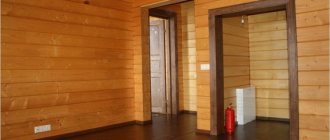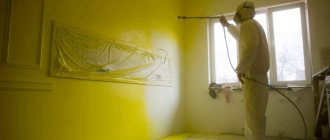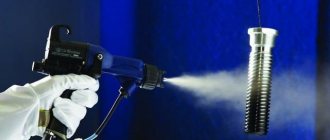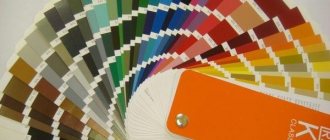Surface painting
Depending on the composition of the work performed, surface painting
Simple painting is used for finishing the surfaces of utility rooms, warehouses and other secondary premises and temporary buildings.
Improved painting is used for finishing residential, civil and industrial buildings and structures.
High-quality painting is used when finishing the main premises of clubs, theaters, stations, administrative and other permanent buildings and public structures, as well as in all cases where there are special instructions in the project.
Based on the type of solvents and binders, paint compositions are divided into water-based, oil-based and varnishes.
Aqueous paint compositions are diluted with hp water. Lime, plant and animal glues, casein and liquid glass are used as binders in aqueous compositions.
| Name, color | Used with binders | Covering power in g/m2, calculated on dry basis. pigm. | Light fastness /toxicity | Alkali resistance | Scope and limitations |
| White lead | M | 185 | +++/+++ | – | For critical external metal coatings |
| Zinc whitewash | MES Em | 100 | +++/+ | + | For external and internal coatings on metal, wood and plaster |
| Yellow ocher | K, Kz, E Em, I, M, S | 65–90 | +++/- | + | For all types of work |
| Mars is velvety yellow. | K, Kz, E, I, M. S | 20 | +++/- | + | For decorative works |
| Lead lemon crown. yellow orange | K, E, Em M | 40 ) 60-65 I 115- 190) | +/++ | – | For interior and exterior coatings. For plaster it is permissible only if the lime is carbonated |
| Green lead | Um, M | 17–42 | ++/++ | – | Same |
| Ultramarine blue. | K, M | — | ++/- | + | In oil it is used in discolorations. Not suitable for lime paints |
| Natural brown umber with a green tint. | K. Kz, E, Em I, M, S | 40 | +++/- | + | For all types of work |
| Painter's blue (milori), dark blue | K, M | – | ++/- | – | Additive for white colors |
| Iron lead, red brick | |||||
| K, Kz, E, Em, I, M, S, | 20 | +++ | + | For all types of colorful work. Has anti-corrosion properties | |
| The mummy is natural, brick brown. | K, Kz, E, Em, I, M | 30-60 | +++ | + | For all types of work |
| Ultramarine green. | K, Kz, E | ++ | + | With oil and all water-based binders for interior and exterior coatings. Not applicable with limestone | |
| Red-orange lead lead. | M | 100 | +/+++ | + | In oil compositions Has high anti-corrosion properties |
| Crown bright red. | E, M | 35-125 | ++/++ | + | For all types of work, has anti-corrosion properties |
Notes. Designations of binders: M - oil, Em - emulsion, S - silicate, I - lime, E - enamel. The lightfastness of pigments is indicated by the following signs: ( + + +) – the most lightfast, ( + + ) – medium resistant, ( + ) – low resistant, (–) – unstable. The alkali resistance of pigments is indicated by the following signs: ( +) – alkali-resistant, (–) – unstable. The toxicity of pigments is indicated by the following signs: (+ + +) – highly toxic. ( + +) – medium toxicity, (+) – low toxicity, (–) – harmless.
Table 243 — Oil paints, thickly rubbed
| Name of paints, color | Dry matter content in % | Binder content in % | Duration of complete drying at 20° in hours | Paint hiding power in g/m2 | Application area | |
| thickly grated | ready to eat | |||||
| Whitewashed white zinc marks: | For external and internal painting on metal, wood and plaster | |||||
| M-00 | 84-80 | 16–20 | 24 | 141 | 120 | |
| M-0 | 84-81 | 14– 9 | 24 | 144 | 170 | |
| B-00 | 86-80 | 14-20 | 24 | 146 | 175 | |
| IN 20 | 88-83 | 12-17 | 24 | 167 | 195 | |
| White lead white marks: | For exterior painting | |||||
| 00 | 82 | 16 | 24 | 130 | 170 | |
| 84 | 14 | 24 | 140 | 190 | ||
| № 1 | 85 | 13 | 24 | 110 | 160 | |
| № 2 | 87 | 11 | 24 | 120 | 190 | |
| Red brick iron lead | 78–82 | 22-18 | 24 | 28 | 35 | For all types of painting |
| Light yellow ocher | 66–72 | 34–28 | 24 | 130 | 180 | For all types of painting |
| beige | 86-82 | 14 18 | 24 | 190 | ||
| protective | 79-74 | 21-26 | 24 | 120 | ||
| gray | 86 82 | 14-18 | 24 | 135 | ||
| blue | 86-82 | 14-18 | 24 | 130 | ||
| umber | 70-74 | 30-26 | 24 | 45 | 60 | |
| light mummy | 75–79 | 25-21 | 24 | 70 | 95 | |
Oil compositions are diluted with natural and artificial drying oil and emulsion diluents.
The moisture content of the plaster before painting it with adhesive and oil compositions should not exceed 8%, and the moisture content of the wood being painted should not exceed 12%.
TECHNOLOGY FOR PRODUCTION OF PAINTING WORKS.4. Surface painting
Depending on the purpose of the buildings, the category of painting work is determined. There are three types of painting in terms of quality: simple, advanced and high quality. The difference between them is determined by how well the surface of the wall or ceiling is prepared for painting, as well as the quality of preparation and application of coloring compositions to the surface. The finishing category is assigned depending on the requirements for finishing. All coloring compositions are applied to the surface in a thin and even layer so that no brush marks are visible and the entire surface is painted evenly without smudges.
4.1. Color categories
Simple painting is used for finishing the surfaces of utility and temporary buildings, warehouses and other secondary structures.
Improved coloring is used for finishing residential, public, educational and domestic premises with constant occupancy.
High-quality painting is used for finishing theatres, clubs, train stations, palaces of culture and similar public buildings. The higher the requirements for the quality of finishing of buildings, the more operations have to be performed when preparing surfaces for painting.
Coloring is divided into internal and external . External painting is subject to higher requirements in terms of weather and frost resistance of painted facades, enclosing structures of loggias and balconies.
The surface to be painted can be smooth or rough; the latter is called “shagreen” painting and is suitable for painting ceilings, staircase walls and building facades. Depending on the intensity of gloss, painted surfaces are divided into glossy and matte. When decorative and artistic finishing, wall surfaces can be painted to resemble valuable types of wood or expensive fabrics.
4.2. Painting surfaces with water-based compounds
Water-based compositions include lime, glue, silicate and casein paints. Lime compositions are used when painting facades on plaster and stone, concrete surfaces, as well as plastered rooms with high humidity - for sanitary facilities and basements, but only without permanent occupation of people.
The water-based composition for painting ceilings is called whitewash. The whitewash composition includes sifted chalk (150 g), blue (6 g), carpenter's glue (15 g) and water (5 l). The constituent materials are thoroughly mixed, and wood glue of a liquid consistency is introduced into the resulting solution. Blue (ultramarine) is necessary to give the coating the necessary whiteness (blueness) and neutralize the yellowness coming from chalk.
Adhesive compositions are used for interior painting on surfaces plastered or covered with sheets of dry plaster.
Silicate painting is suitable for plaster, concrete, brick and wooden surfaces. Silicate compositions are a mixture of alkali-resistant mineral pigments and liquid potassium soluble glass with water; They have good fire-retardant properties, are less dirty and can be easily washed with soap and water. In addition, silicate inorganic paints are intended for painting old surfaces on concrete, lime and lime-cement plaster, and sand-lime brickwork. It fits well on surfaces previously painted with lime, lime-cement, cement and silicate paint.
Lime-cement paint is prepared using a mixture of white cement and slaked lime. It consists of filler and pigments. The inorganic base of the binders allows the paint layer to easily transmit moisture released inside the building. It is designed not only for painting interior and exterior surfaces of buildings, but also for protecting and painting new and old clay brick and lime cement plaster surfaces.
Casein painting is used for facades and interior dry plastered and brick surfaces. The coloring is similar to adhesive, but adhesion is higher and peelability is much lower than that of adhesive compositions.
4.3. Painting surfaces with oil compounds
Non-aqueous formulations include varnish, enamel and oil formulations.
Paint is a suspension of finely ground pigment with filler in drying oil, varnish, emulsion, latex. When drying, volatile components evaporate and a film coating forms. Non-aqueous construction paints include oil and enamel paints. Oil paints are produced as thickly grated (paste-like) and liquid (ready-to-use). Enamel paints are prepared from pigments ground with various varnishes.
Varnish is a solution of a substance capable of forming a transparent, uniform coating on the surface after evaporation of the solvent. Varnishes give surfaces a decorative look and at the same time form a durable protective coating. Most of the varnishes produced are colorless, but varnishes with coloring pigments and black ones (based on petroleum bitumen and coal tar) are also used.
Enamel is a suspension of pigment in varnish that, after drying, forms an opaque, hard, protective, decorative film with a certain texture. Enamels are divided into oil, alkyd, epoxy, etc. Epoxy enamels are most often used for painting metal surfaces.
Oil painting is used in residential and public buildings, shops, cafes, and canteens. The compositions are prepared by mixing pigments with drying oil; to speed up drying, driers are added to the applied coating (but not for the top layer). To prepare oil paints, thickly ground white or colored pigments are used, dissolved in natural drying oil or oxol drying oil. Oil compositions allow you to create not only a decorative finish for surfaces, but also protect them from moisture or corrosion.
4.4. Painting surfaces with synthetic compounds
Synthetic painting compositions are prepared using resins (perchlorovinyl, organosilicon, etc.). Paints mixed on them can be water-based or solvent-based.
Water-based synthetic paints are used for interior decoration of buildings and structures, and paints based on organic solvents are used for exterior decoration. Perchlorovinyl resin, dissolved in organic solvents with the addition of pigments and fillers, has found wide application in the production of exterior finishing works in winter conditions.
Water-dispersion paint is an aqueous solution of polymers, pigment, fillers based on chalk, kaolin, silica, talc and mica. To give paints special properties, emulsifiers, dispersants (grinders) and other chemicals are added to them. Unlike adhesive compositions, water-dispersion paints are resistant to washing and wiping with water.
Polyvinyl acetate water-dispersion paints are prepared using polyvinyl acetate emulsion and pigment with the addition of a stabilizer and plasticizers. The paints are intended for interior decoration of buildings on plaster, asbestos-cement sheets, concrete, wood, gypsum and plaster surfaces. For metal, paint compositions can be applied after preliminary priming of the surface with an oil or varnish composition. The rapid drying of paint is determined by the time it takes for water to evaporate from it, which makes up approximately 40% of the paint.











